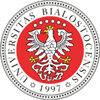Proszę używać tego identyfikatora do cytowań lub wstaw link do tej pozycji:
http://hdl.handle.net/11320/18989Pełny rekord metadanych
| Pole DC | Wartość | Język |
|---|---|---|
| dc.contributor.author | Litwin, Maciej | - |
| dc.date.accessioned | 2025-10-09T06:42:44Z | - |
| dc.date.available | 2025-10-09T06:42:44Z | - |
| dc.date.issued | 2025 | - |
| dc.identifier.citation | Linguodidactica, T. 29, 2025, s. 129-142 | pl |
| dc.identifier.uri | http://hdl.handle.net/11320/18989 | - |
| dc.description.abstract | The study looked at 94 re-translations of the same source text in order to investigate anchoring effects in translation decisions. The analysis focused on two two-level explanatory variables corresponding to binomial grammatico-syntactic choices and tested anchoring effects against the proposed equivalence measure (length production metric related to object range estimate in context). The anchoring effect was observed in 0.7 of re-translations for both explanatory variables. When tested for statistical significance of the equivalence measure, the anchoring group contained versions whose length-to-words ratio was higher when the original anchor was an unidiomatic verb phrase, and versions whose length-to-words ratio was lower when the original anchor was idiomatic syntax corresponding to human-scale conceptualization of a tourist visit scenario (although the results were up to two per cent short of the statistical significance threshold for both tests). | pl |
| dc.description.abstract | W badaniu przeanalizowano 94 tłumaczenia tego samego tekstu i dokonano obserwacji efektu zakotwiczenia w decyzjach tłumaczeniowych. Analiza skupiła się na dwuwartościowych decyzjach tłumaczeniowych, odpowiadających opcjom gramatyczno-syntaktycznym, które przetestowano w oparciu o zaproponowany metakognitywny miernik ekwiwalencji (pomiar długości względem szacunkowej liczby obiektów w wypowiedzeniu). Efekt zakotwiczenia zaobserwowano w 70 procentach tłumaczeń zarówno dla pierwszej jak i drugiej zmiennej objaśniającej. W badaniu istotności statystycznej średni iloraz długości i liczby słów w zdaniach był większy dla grupy z efektem zakotwiczenia, kiedy zakotwiczenie opierało się na nieidiomatycznym orzeczeniu oraz mniejszy, gdy zakotwiczenie opierało się na naturalnej konceptualizacji scenariusza zwiedzania (rezultaty obu testów blisko progu istotności statystycznej). | pl |
| dc.language.iso | en | pl |
| dc.publisher | Wydawnictwo Uniwersytetu w Białymstoku | pl |
| dc.rights | CC BY-SA 4.0 Uznanie autorstwa – Na tych samych warunkach | pl |
| dc.rights.uri | https://creativecommons.org/licenses/by-sa/4.0/deed.pl | pl |
| dc.subject | translation equivalence metrics | pl |
| dc.subject | anchoring bias | pl |
| dc.subject | re-translation corpora | pl |
| dc.subject | pomiar ekwiwalencji w tłumaczeniu | pl |
| dc.subject | zakotwiczenie | pl |
| dc.subject | korpusy tłumaczeń | pl |
| dc.title | Translation and Anchoring Bias: A Study of Equivalence in English-Polish Student Translation Tasks | pl |
| dc.title.alternative | Tłumaczenie a efekt zakotwiczenia. Badanie ekwiwalencji w angielsko-polskich tłumaczeniach dokonanych przez studentów filologii angielskiej | pl |
| dc.type | Article | pl |
| dc.rights.holder | CC BY-SA 4.0 Uznanie autorstwa – Na tych samych warunkach | pl |
| dc.identifier.doi | 10.15290/lingdid.2025.29.09 | - |
| dc.description.Email | maciej.litwin@uwr.edu.pl | pl |
| dc.description.Affiliation | University of Wrocław | pl |
| dc.description.references | Blumczynski P., Experiencing translationality: material and metaphorical journeys, Abingdonon-Thames 2023. | pl |
| dc.description.references | Davier L., Translating news, [in:] The Cambridge handbook of translation, K. Malmkjaer (ed.), pp. 401–420. | pl |
| dc.description.references | Epley N., Gilovich T., Anchoring unbound, “Journal of Consumer Psychology” 2010, 20 (1), pp. 20–24. | pl |
| dc.description.references | Grice P., Logic and conversation, [in:] Syntax & semantics, P. Cole, J.L. Morgan (eds.), Cambridge, MA 1975. | pl |
| dc.description.references | Jakobson R., On linguistic aspects of translation, [in:] The translation studies reader, L. Venuti (ed.), Routledge 2000 [1959], pp. 113–118. | pl |
| dc.description.references | Koller W., Einführung in die Übersetzungswissenschaft, Heidelberg 1979. | pl |
| dc.description.references | Langacker R., The cognitive grammar, Oxford 2008. | pl |
| dc.description.references | Lee T.K., Translation and translanguaging in (post)multilingual societies, [in:] The Cambridge handbook of translation, Cambridge 2022, pp. 120–138. | pl |
| dc.description.references | Pym A., Hao Y., How to augment language skills. Generative AI and machine translation in language learning and translator training, Abingdon-on-Thames 2025. | pl |
| dc.description.references | Pym A., Explaining translation theories, Abingdon-on-Thames 2010. | pl |
| dc.description.references | Tversky A., Kahneman D., Judgment under uncertainty: heuristics and biases, “Science” 1974, 185. | pl |
| dc.identifier.eissn | 2957-0204 | - |
| dc.description.volume | 29 | pl |
| dc.description.firstpage | 129 | pl |
| dc.description.lastpage | 142 | pl |
| dc.identifier.citation2 | Linguodidactica | pl |
| dc.identifier.orcid | 0000-0001-5881-5550 | - |
| Występuje w kolekcji(ach): | Linguodidactica, 2025, tom XXIX | |
Pliki w tej pozycji:
| Plik | Opis | Rozmiar | Format | |
|---|---|---|---|---|
| Linguodidactica_29_2025_M_Litwin_Translation_and_Anchoring_Bias.pdf | 249,24 kB | Adobe PDF | Otwórz |
Pozycja ta dostępna jest na podstawie licencji Licencja Creative Commons CCL


